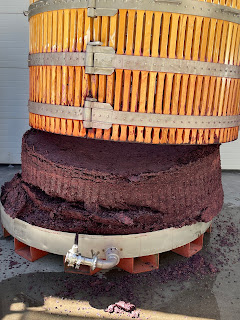What's in a harvest?
Harvest is always the most exciting time of the year at any winery. It's when the fruit of the entire year's labor, literally, is turned into the product that coaxed us all into this business in the first place. But what happens during harvest and crush? Here is a peek into the stages at our family winery:
SAMPLING
 |
| Winemaker Joe tests berries for sugar and acidity |
We need to know when the grapes will be ripe, so we "sample" each block - picking either 100 berries (approx.) or a number of whole clusters. We then test sugar, total acidity and pH.
Some of these things we test in-house, and some we send out to a winery lab to test for us. We also taste berries for flavor, taste stems (yes, taste) for tannin -- an important structural component in wines -- and watch the weather. All of these items will help inform us when to pick.
We believe we have an advantage that we only work with one vineyard. This allows us the time and focus to pinpoint the best day to harvest our estate-grown grapes.
PICKING
Because we only source from our Charles vineyard, when our fruit is ripe it tends to come in rapidly, starting with our Vin Gris (rosé) and ending with our Semillon.
We work with local crews to bring everything in quickly and in good condition. Yes, we have picked blocks ourselves as a family, but we will give credit where credit is due -- the crews are faster and better!
Harvests are early morning until the crews start working night shifts, and then we are the latest possible pick during their "day" - Boonville is at its coldest right before daybreak, which is when we want our fruit.
Because our grapes never travels on a truck, we have the time to hand-sort each cluster that the tractors deliver to the winery. Leaves, stems without berries, or under-or-overripe clusters are sorted out, and fed to our neighbor's cattle.
Our family sorts our fruit each year, carefully selecting the whole clusters, and then sorting the best bunches to go through the destemmer, until the fermentation bins are full and pushed into the winery for the next stage.
On white wine day, the clusters are pressed and only the juice is used for fermentation.
FERMENTATION AND PUNCHDOWNS
All our wines are fermented only with wild yeast, so once we sort and destem, the bins are pushed into the winery and we wait! Like magic, the bubbles start and fermentation begins.
To keep the fermentations oxygenated and healthy, we "punch down" by hand, one to three times per day, for 3-4 weeks (see photo). Yes, it's hard on the arms!
This is peak winemaking time, and typically the vineyard is done being picked at this point. This means we can concentrate solely on making the best wine for the vintage.
PRESSING
We press our Pinot Noirs in a traditional, wooden basket press made for Champagne (or cava as the press was manufactured in Spain).
This press is very gentle and allows our winemaker to taste the new wine as its being pressed, ending when his palate indicates the right balance has been achieved.
From the press, the wines go into barrel or tank for nearly a year, until they're bottled in a mobile line that comes to our winery site.
The next stop: after aging in bottle, they arrive at your glass!



Comments